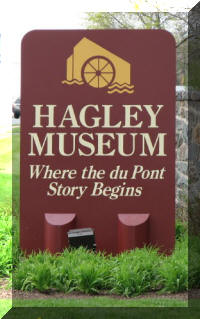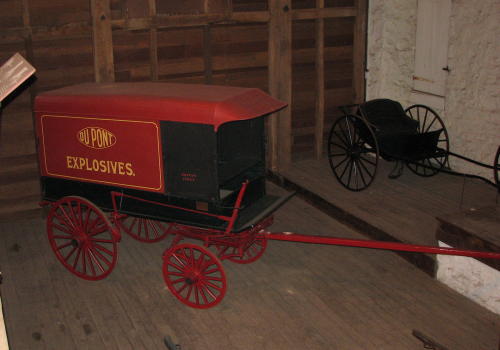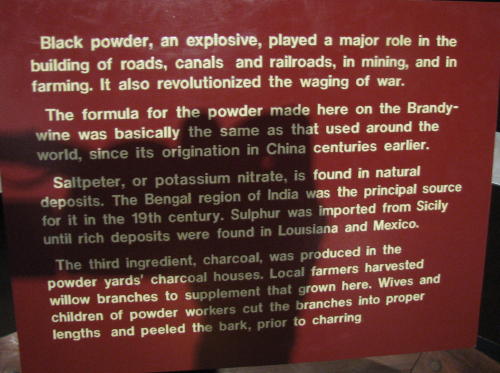 The Hagley museum is located in Wilmington, Delaware.
The visitor center and most of the other buildings were made from stone
quarried on the property.
The Hagley museum is located in Wilmington, Delaware.
The visitor center and most of the other buildings were made from stone
quarried on the property.Hagley Museum - 2009
Updated: 04/27/09
The Hagley Museum is an example of early American industry featuring indoor and outdoor exhibits. The grounds include restored mills, a workers' community and the ancestral home and garden of the du Pont family. We have visited many similar villages on our travels. Mary Lou was most interested in the manufacture of gunpowder. So most of our time was spent learning about the gun powder manufacturing process.
 The Hagley museum is located in Wilmington, Delaware.
The visitor center and most of the other buildings were made from stone
quarried on the property.
The Hagley museum is located in Wilmington, Delaware.
The visitor center and most of the other buildings were made from stone
quarried on the property.
One of the many water ways runs beside the visitor center.
To
us the Brandywine River running through the property was beautiful. To them, it
was a source of power.
The only way for visitors to get to the family home was using a shuttle bus. The bus drove along the river where we saw the Millwright and Machine shop and the powder yard. The shuttle made limited stops on the route.
A water wheel was positioned between two building.
The
wheel drove a single shaft that provides power to both buildings.
The
water level in the canals was controlled by a dam. Once the desired level was
reached, the water spilled over the retaining wall back into the Brandywine
River.
The
driver pointed out that at this time of the year you can see a du Pont brother's
house across the river. Most of the year, foliage blocks the view.
Again, it is a beautiful location.
An old grinding wheel was used as a memorial to E. I. du Pont.
The shuttle bus made its first stop . . .
This area features the first du Pont family home, garden, barn and First Office. The house was named for its owner, Eleuthere Irenee duPont. He acquired the sixty-five acre site in 1802 to build a gunpowder manufactory. This is a guided tour. This area is reached by bus only.
Eleutherian Mills - The du Pont Family Home
Photography was not permitted inside the family home. When we walked out on the porch, the tour guide turned to Fred and told him he could make photographs on the porch. The iron work was very ornamental. Even the porch roof and framing was iron work.
From the porch a statue could be seem at the edge of the pond. It was one of very few statues remaining on the property.
This
iron work looked like it was designed to hold pots of oil or candles. It was very
attractive.
The
First Office (1837) reflects business practices of the nineteenth century.
The wagon, carriage and car exhibit located near the house included a Du Pont car.
The 'baby' du Pont and the Detroit Electric Car were also displayed on the lower level.
The upper level displayed the wagons and carriages.
 Considering
the family business was making gun powder, this wagon was well placed.
Considering
the family business was making gun powder, this wagon was well placed.
The shuttle bus stopped for a demonstration at the Steam Engine House. During times of the year when the Brandywine River did not provide enough power, the steam engine was used. Using belts and pulleys the power was delivered to buildings on the property.
Drying boards were laid out on the racks to dry gun powder. When not in use, the boards were stacked and covered with a roof.
One of the reasons the Hagley property was desirable was the availability of stone for the buildings.

A
canal ran behind the Millwright and Machine shop.
Inside the building the water was used to turn shafts, belts and pulleys to powered a wide variety of machines.
The demonstration showed how the speed of the machines was controlled by the placement of the belts on different pulleys. The demonstration also showed the operation of various cutting tools. Each shaft and gear used to transfer power was made in this shop.
These
cone-shaped pulleys provided a wide range of speeds.
One educational model showed how gears were used to change the direction of power.
This
is a huge drill press. Afterward, Fred wished he had the machinist hold her hand
on the drill bit to better show its size. It had to be 12 inches in diameter.
This shop made the transfer of power to all parts of the property possible.
At 1:30pm the day we visited Hagley, they held a program for children.
Do not miss the gun powder demonstration in the Powder Yard.
Click on the image above enlarge the plaque.
This fellow opened the gate to let water into the pipe and through a turbine. The gearing transferred the power from the turbine to the horizontal shaft leading into the buildings.
This
gate, at another location, shows how lowering and raising would control the flow of water into the
pipes leading to the turbines and water wheels.
Back to the demonstration . . . These wheels were pulverizing the ingredients to make gun power. A blade moved the gun power from the inside and outside edge into the center to insure the wheel were very effective. Gunpowder is made from saltpeter, sulphur and charcoal.

This was a very dangerous operation. The Roll Mills were thick three sided buildings. In the event of an explosion, the force of the blast would be towards the river.
Ah, we get to blow something up!
Well, not really. He showed us how 'grainy' gun powder is. The gauge on the rail is a gun powder tester. A salesman would take it to prospective customer to demonstrate how a like amount of du Pont's gun powder would move the gauge farther than competitor's gun powder.
He loaded some gun powder in the tester, lit the fuse and stepped away.
The DuPont Company manufactured gunpowder and blasting powder here from 1802 until 1921 when the yards shut down. By then, the company was making a transition from producing explosives to researching and developing chemical products.
WARNING
to RVers
. . . We suggest you drive a small vehicle to the Hagley. Because we were
also towing the utility trailer we picked up in Pennsylvania, we called ahead to
ask about RV parking. While they told us they had RV parking, it was not a very
'RV friendly' parking lot. If it had been a busy time, anyone towing a trailer
or a vehicle behind a motorhome would have been in trouble. We were able to make
a u-turn in the parking lot only because the rear of the HHII could hang over
the curb and the utility trailer could go over the curb.
Admission was $9.00. We spent four hours and could have spent the entire day to see all that is available. We found it a very interest place to visit. Regular hours are 9:30 a.m. to 4:30 p.m. Visit their Web site at www.hagley.org for detailed information.